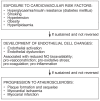Endothelial dysfunction: the early predictor of atherosclerosis
- PMID: 22614668
- PMCID: PMC3721957
- DOI: 10.5830/CVJA-2011-068
Endothelial dysfunction: the early predictor of atherosclerosis
Abstract
Since the discovery in the 1980s that nitric oxide (NO) is in fact the elusive endothelium-derived relaxing factor, it has become evident that NO is not only a major cardiovascular signalling molecule, but that changes in its bioavailability are crucial in determining whether atherosclerosis will develop or not. Sustained high levels of harmful circulating stimuli associated with cardiovascular risk factors such as diabetes mellitus elicit responses in endothelial cells that appear sequentially, namely endothelial cell activation and endothelial dysfunction (ED). ED, characterised by reduced NO bioavailability, is now recognised by many as an early, reversible precursor of atherosclerosis. The pathogenesis of ED is multifactorial; however, oxidative stress appears to be the common underlying cellular mechanism in the ensuing loss of vaso-active, inflammatory, haemostatic and redox homeostasis in the body's vascular system. The role of ED as a pathophysiological link between early endothelial cell changes associated with cardiovascular risk factors and the development of ischaemic heart disease is of importance to basic scientists and clinicians alike.
Figures





Comment in
-
Endothelial dysfunction: are we ready to heed the vasculature's early-warning signal?Cardiovasc J Afr. 2012 May;23(4):184-5. Cardiovasc J Afr. 2012. PMID: 22614658 Free PMC article. No abstract available.
References
-
- Steyn K. Fourie JM MRC; 2007. Heart Disease in South Africa.
-
- Geneva: WHO; 2009. Global health risks: Mortality and burden of disease attributable to selected major risks.
-
- Lahoz C, Mostaza JM. Atherosclerosis as a systemic disease. Rev Esp Cardiol. 2007;60(2):184–195. - PubMed
-
- Choi D, Hwang K-C, Lee K-Y, Kim Y-H. Ischemic heart disease: current treatments and future. J Contr Release. 2009;140:194–202. - PubMed
-
- Deanfield JE, Halcox JP, Rabelink TJ. Endothelial function and dysfunction: Testing and clinical relevance. Circulation. 2007;115:1285–1295. - PubMed
Publication types
MeSH terms
Substances
LinkOut - more resources
Full Text Sources
Other Literature Sources
Medical

